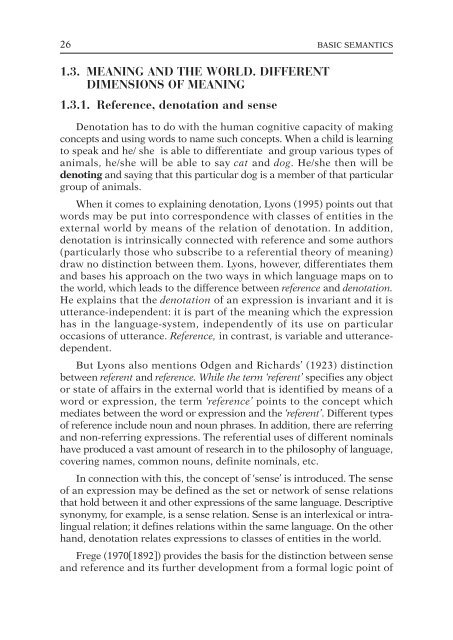Semantics
You also want an ePaper? Increase the reach of your titles
YUMPU automatically turns print PDFs into web optimized ePapers that Google loves.
26 BASIC SEMANTICS<br />
1.3. MEANING AND THE WORLD. DIFFERENT<br />
DIMENSIONS OF MEANING<br />
1.3.1. Reference, denotation and sense<br />
Denotation has to do with the human cognitive capacity of making<br />
concepts and using words to name such concepts. When a child is learning<br />
to speak and he/ she is able to differentiate and group various types of<br />
animals, he/she will be able to say cat and dog. He/she then will be<br />
denoting and saying that this particular dog is a member of that particular<br />
group of animals.<br />
When it comes to explaining denotation, Lyons (1995) points out that<br />
words may be put into correspondence with classes of entities in the<br />
external world by means of the relation of denotation. In addition,<br />
denotation is intrinsically connected with reference and some authors<br />
(particularly those who subscribe to a referential theory of meaning)<br />
draw no distinction between them. Lyons, however, differentiates them<br />
and bases his approach on the two ways in which language maps on to<br />
the world, which leads to the difference between reference and denotation.<br />
He explains that the denotation of an expression is invariant and it is<br />
utterance-independent: it is part of the meaning which the expression<br />
has in the language-system, independently of its use on particular<br />
occasions of utterance. Reference, in contrast, is variable and utterancedependent.<br />
But Lyons also mentions Odgen and Richards’ (1923) distinction<br />
between referent and reference. While the term ‘referent’ specifies any object<br />
or state of affairs in the external world that is identified by means of a<br />
word or expression, the term ‘reference’ points to the concept which<br />
mediates between the word or expression and the ‘referent’. Different types<br />
of reference include noun and noun phrases. In addition, there are referring<br />
and non-referring expressions. The referential uses of different nominals<br />
have produced a vast amount of research in to the philosophy of language,<br />
covering names, common nouns, definite nominals, etc.<br />
In connection with this, the concept of ‘sense’ is introduced. The sense<br />
of an expression may be defined as the set or network of sense relations<br />
that hold between it and other expressions of the same language. Descriptive<br />
synonymy, for example, is a sense relation. Sense is an interlexical or intralingual<br />
relation; it defines relations within the same language. On the other<br />
hand, denotation relates expressions to classes of entities in the world.<br />
Frege (1970[1892]) provides the basis for the distinction between sense<br />
and reference and its further development from a formal logic point of



